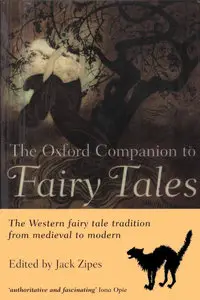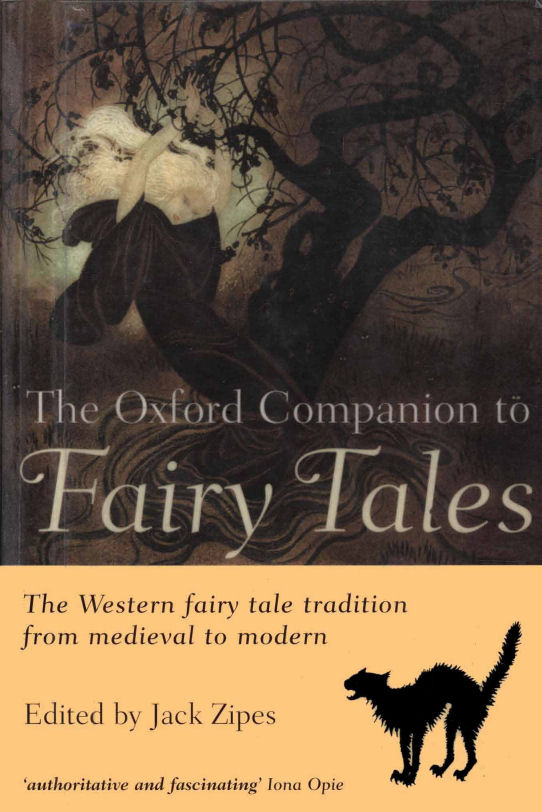Jack Zipes, "The Oxford Companion to Fairy Tales"
Oxford University Press | 2002 | ISBN: 0198605099 | siPDF | 640 pages | 27.2 MB
Oxford University Press | 2002 | ISBN: 0198605099 | siPDF | 640 pages | 27.2 MB
From its ancient roots in the oral tradition to the postmodernist reworkings of the present day, the fairy tale has retained its powerful hold over the cultural imagination of Europe and North America. Now The Oxford Companion to Fairy Tales provides the first authoritative reference source for this complex, captivating genre.
With more than 800 entries written by a team of 67 specialists from around the world, the Companion offers an illuminating look at the classic tales themselves, both ancient and modern, from Jack and Jill and Cinderella to Alice in Wonderland and the Wizard of Oz. The contributors also profile the writers who wrote or reworked these luminous tales, as well as the illustrators, film-makers, choreographers, and composers who have been involved with creating or interpreting them. The Companion also covers such related topics as film, art, opera, ballet, music, even advertising.
An introductory overview by Jack Zipes sets the subject in its historical and literary context, and special survey articles explore the development of the fairy-tale tradition in individual countries, focusing particularly on the European and North American traditions. The volume includes a detailed bibliography, to aid in further research into this fascinating topic. Strikingly illustrated with 70 beautiful pictures, from early engravings to 20th-century film stills, this is an essential companion for everyone who loves fairy tales and storytelling.
Amazon.com Review
This comprehensive guide is as wonderfully thorough and cross-referenced as we've come to expect from the Oxford Companions, and it deserves a place on the bookshelf of any lover of children's literature or films.
Arranged alphabetically, The Oxford Companion to Fairy Tales covers authors, illustrators, individual titles, and countries of origin for the fairy tales of Europe, from medieval times through the era of Walt Disney. Each entry is handily marked with asterisks when there's a related section to read; "The Little Mermaid" has asterisks highlighting both Hans Christian Anderson and Disney, while the larger section of Victorian Fairy Painting has 19 asterisks in its three pages of text.
While authors and stories generally don't get more than a few paragraphs of detail, you'll find the quantity of entries most impressive. Beyond standard fairy tales, authors of classic children's literature and adult fantasy are often included, if their works rely in any way on earlier myths or tales—Terry Pratchett and Maurice Sendak are two examples. Larger sections devoted to regional differences are lengthy and fascinating, and they include Portugal, Spain, France, North America, Britain, and Italy. The book also has plenty of illustrations.
While they're all in black and white, the variety of artistic styles is wonderful, and each plate is large enough to show charming details of giants, maidens, witches, and all the classic characters of these beloved stories. Whether your heart lies with Edward Gorey or Kate Greenaway, you're sure to enjoy the facts behind your favorite tale.
From Library Journal
The Märchen, or fairy tale, is widely defined as a fictitious narrative with a human main character; it includes fantasy and is told as a means of instruction and/or entertainment. Born out of oral tradition, the tales contain many thought-provoking layers, including ancient incredulities, archetypical fears, contemporary folk beliefs, exquisite superstition, heartfelt wishes, and social commentary.
This well-documented volume contains 800 signed entries authored by 67 authorities from around the world. No actual tales are included; instead, this reference is an illuminating collection of brief essays on classic tales, both modern and ancient. In alphabetical order, the companion profiles noted authors, illustrators, filmmakers, choreographers, and composers; more broadly, it covers film, art, opera, ballet, music, and commercial use.
Zipes, a major authority on the subject, lets readers explore the development of the fairy-tale tradition in various countries, paying special attention to European and American writings. Attractive, well written, and approachable, this solid guide to the fairy-tale world is without equal. Recommended for all public and academic libraries.
From Booklist
Zipes, professor of Dutch, German, and Scandinavian Literatures at the University of Minnesota, has edited an exemplary addition to the Oxford Companion series. Sixty-seven scholars from around the world have contributed entries. The introduction attempts to define the fairy tale as a genre by tracing its history from ancient times and the oral tradition to the current postmodern and Walt Disney era while stressing its importance and its powerful influence over the cultures of Europe and North America, the areas covered in this volume.
The more than 800 entries are arranged in alphabetical order with long articles on the fairy tales of each country or region set off by William Morris-style margin decorations. The national overviews include a bibliography, and each concept, author, or title that is an entry elsewhere in the book is starred as a see also reference. The entry on Spain begins by mentioning universally recognized stories such as Cinderella (Cenicienta) and Little Red Riding Hood (Caperucita Roja), then gives a history of the fairy tale beginning with the Arab influences of the eleventh century and ending with the magical realism movement in literature in the twentieth century. This chronological format is used in all country or regional survey articles.
Other entries profile important tales and the writers who wrote or rewrote them, as well as illustrators, composers, choreographers, and filmmakers who have interpreted them. Zipes also makes a point of including entries for compilers such as the Brothers Grimm; and folklorists, ethnographers, and historians, such as Giuseppe Pitre, an Italian folklorist of the nineteenth century. There are a number of thematic entries, such as Feminism and fairy tales, Psychology and fairy tales, and Science fiction and fairy tales; an index would have facilitated access to the information contained in these detailed discussions. The volume is nicely illustrated with 70 pictures ranging from nineteenth-century engravings to film stills and photographs from dance productions. Following the entries are a lengthy bibliography of fairy-tale studies and bibliographies of both classic and other collections for further reading.
Tags: FairyTales, Literature, LiteraryCriticism, Mythology



